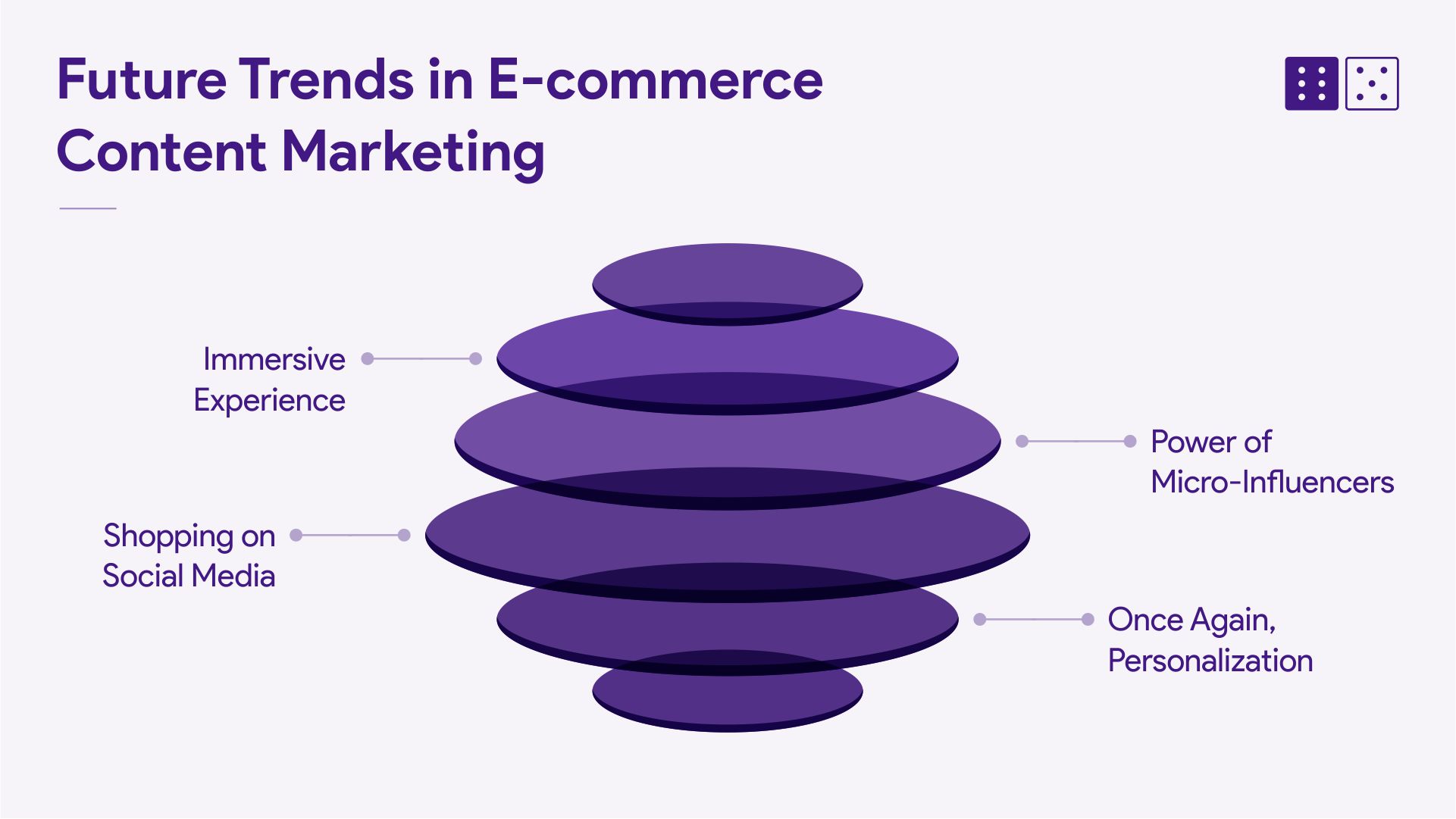eCommerce and Content Synergy: Crafting a Winning Content Strategy
Companies known to use, sell, or share user data to train AI models Companies known to use, sell.

Imagine you have a store. You have innumerable competitors. But you’re not shouting your product offers like them, you’re having friendly conversations with potential customers. Can you imagine how different the experience would be for those potential customers? That’s the magic of content marketing for ecommerce! It’s important to get over the pressure to just sell. Work on creating content that speaks directly to your audience’s needs and questions–answer their queries about your products, offer insightful tips. Don’t shy away from sharing some fun brand stories.
Consider it like building a relationship (maybe friendship) with your potential customers. When content marketing is done right, you earn your customers’ trust. They will definitely consider you when they’re ready to buy. Thus, spread your friendly voice across social media, search engines, and even targeted ads.
You want to show up consistently with helpful content so that you become a go-to resource for them, and not just another online store. And that’s how, content marketing for ecommerce is the key to unlocking a loyal customer base and watching your online store thrive.
Ecommerce content writing is all about building connections with your audience. To do this, you craft valuable content that supports their entire buying journey. The content informs, engages, and entertains them while showcasing your brand’s expertise. And the objectives for your brands are clear:
It’s a long-term investment. It impacts the organic traffic, customer loyalty and the ROI is undeniable. Stats say that 82% of marketers actively use content marketing, and 96% of ecommerce companies see positive results. In the ecommerce strategies, content marketing becomes the fuel that gets the engine running:
Valuable content is the key. By being audience-centric, you build lasting relationships and fuel your ecommerce success in the long run.
Creating a strategy for content marketing is even more important than the content. Without a strategy, your efforts in generating the content will go in vain. We’ve broken down the key steps involved in creating an impactful strategy.
Also, generic messaging won’t cut it anymore. To have your audience listen, you need to speak their language. And you learn this through buyer personas. Arm yourself with insights into your audience’s deepest desires, biggest fears, and buying habits.
Understand their aspirations and where they are in their buying journey. Answer their unspoken questions, address their pain points, and offer solutions that resonate.
Let’s talk about the different content types and how you can leverage them in your content marketing strategy.
You know about blogs. Blog posts can be used for sharing your brand story, showcasing knowledge and promoting new products. Remember to optimize blogs for search engines to attract organic traffic. If regular content generation is the pain, consider utilizing content writing tools like Proco. It also helps implement advanced SEO strategies in your blogs.
Be consistent in sharing captivating content on platforms like Facebook, Instagram, and Pinterest. Post product pictures, short videos, behind-the-scenes glimpses, and user-generated content. Social media is one of the best ways to engage your audience.
You can eliminate the difference between traditional in-store shopping and online buying to a great extent by offering detailed buyer guides. These guides will help customers navigate your products confidently and make informed decisions.
You can easily transform complex information into visually appealing infographics. Infographics are most suitable for sharing technical features, product comparisons, or industry trends in an engaging way.
Resort to video content to showcase your products, make announcements, or to share real-life stories around your brand/products. Include a touch of fun or attention grabbing information and you’re all set to generate leads.
You can help your customers make informed purchase decisions with interactive tools and quizzes. Not only is it a great way to engage your audience and qualify the leads, but also guide them towards the right products.
Product descriptions provide all the necessary information, like size, weight, features, usage precautions, and benefits the customers. But with keyword integration and optimization for search engines, it will redirect potential buyers towards your store.
You can also partner with bloggers and publishers who align with your brand, and they will promote your products on their platforms. This hugely expands your reach to a wider audience and leverages their credibility. You can look for giants like Amazon, who have a well-established affiliate program.
It’s important to have a beautiful website and amazing products. But you need to be seen, heard, and trusted by your target audience too. This is where the duo of content marketing and SEO steps in and helps in the success of your online store. Content marketing is like the captivating story that draws customers in and SEO acts as the map that guides them to your door.
High-quality, informative content can also serve as a treasure trove of relevant keywords and phrases that search engines love. The more valuable content you create, the more opportunities you have to rank higher in search results.
Now that you know the powerful synergy, here are some practical tips for optimizing your ecommerce content writing for search engines:
Use different social media platforms for different purposes. Use Instagram and Pinterest for showcasing products with eye-catching images and videos. When using Pinterest, leverage the “pinning” feature to allow users to save your content. It can drive referral traffic to your website. Facebook offers versatility, so use it to share product updates, blog posts, and videos to engage a wider audience. When it comes to quick announcements and promoting the blogs, use Twitter. YouTube’s video format is to be used for in-depth product demonstrations and brand storytelling.
Apart from social media, you also need to explore influencer marketing. When you collaborate with influencers, your products get introduced to their loyal followers. You would have seen fashion brands partnering with style bloggers to showcase their collection. It is a great way to add value and create authentic connections with potential customers.
We know well that the one-size-fits-all approach is no longer of any use. Today’s customers are subconsciously looking for personalized experiences. And here, relevance plays a crucial role in winning their hearts and wallets. They love the targeted approach as it makes them feel understood and valued.
Also note that Personalization can take various forms–from dynamic product recommendations to blog posts and emails written based on customer interests and purchase history. But for doing this, you’ll have to leverage data and understand individual needs. It will allow you to create content that speaks directly to each customer.
In ecommerce content strategy, understanding the effectiveness of your content marketing efforts is quite important. How to do this when you have so many content formats? Let’s talk about the key performance indicators (KPIs) and tools to measure content effectiveness.
Make a note of the below tools and technique for complete analytics:

The future of effective ecommerce content marketing has nothing to do with static product descriptions and marketing jargon. We will get to see a lot more of experiences that connect with the customers. Thus, today is the time to redefine how you engage with customers:
Don’t you love virtually trying clothes or taking quizzes to find the perfect fit for you? So do your customers. Start working on strategies that can create such experiences for your customers.
Maybe going after celebrity endorsements won’t be as important. We’d rather say that the future is about micro-influencers. They are passionate about what they do and they have engaged communities too. Make them your brand ambassadors and you can leverage their existing deep connections.
Yes, it’s the future! Platforms like Instagram are making it so easy to discover and buy directly within the app. Here, we’re talking about stunning product posts with instant buy buttons. But you’ll need to make sure your content is compelling enough.
You need to understand your customers like never before. Creating personalized experiences based on their interests and needs is a must.
And do not forget to say ahead of the curve.
Keep your mind open. Do not be afraid to try new formats, platforms, and trending technologies. Discover what works best for you and your customers. Make the best use of data to guide your ecommerce content strategy and adapt quickly to evolving trends.
Ecommerce content marketing helps you create experiences that capture the heart of your audience. A strategic content marketing plan that is based on self-awareness, competitor analysis and prioritized keywords will be of great help in doing this.
But do not forget that content is just half the battle. It’s the SEO that will take your audience to the valuable content. A complete SEO and marketing tool like Proco is what you will need in this journey. It helps you with the relevant keywords and compelling titles and descriptions accordingly. Also, backlinks are your votes of confidence, and Proco helps you earn them through effective strategies.
And keep personalizing your content. Use data to understand what your customers want and learn their buying habits. Create a strategy that offers solutions to their pain points and answers their questions. Proco will help you generate content tailored to their interests so that their interactions feel meaningful.
Finally, remember that content marketing for ecommerce is not a one time activity. Keep tracking your progress with KPIs like website traffic, conversions, engagement, and lead generation. With Proco by your side, you’ll have the ability and the insights to fuel your ecommerce success with content that truly connects.
Share
By clicking “Subscribe” you agree to ELEVEN DICE Privacy Policy and consent to ELEVEN DICE using your contact data for newsletter purposes
In the cutthroat world of digital marketing, producing quality leads is essential for business expansion for all types of enterprises. One of the most important tactics for drawing in, interacting with, and winning over new clients is content marketing. This article explores the sophisticated techniques for using content marketing to produce high-quality leads. It focuses […]
SEO is essential for startups who want to create an online presence on a shoestring with minimum funding. Good SEO may increase conversion rates, increase brand visibility, and generate organic visitors. This article explores ten cutting-edge SEO tactics designed for resource-constrained companies, offering a technical road map for optimizing your online presence. 1. Keyword Research […]
Imagine you’re browsing social media and you come across a post or an ad of some celebrities wearing stylish sunglasses from a brand you haven’t heard of before. It is possible that you will search the brand online and discover their website. You may go through their collection, be impressed by the variety and unique […]
Writing tips and examples, best reads, cool tools, jobs, and friendly encouragement to do your best writing. sent weekly, on Thursdays.
Sent weekly, on Thursdays. Costs $0. Unsubscribe any time.
